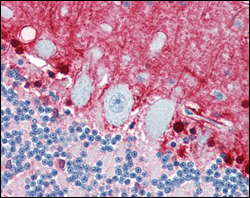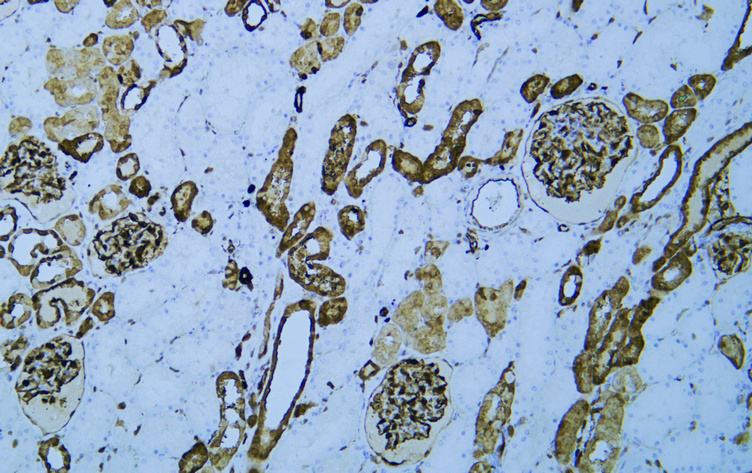S-100 β Monoclonal Antibody
- Catalog No.:YM0572
- Applications:WB;IHC;IF;ELISA
- Reactivity:Human
- Target:
- S100B
- Gene Name:
- S100B
- Protein Name:
- Protein S100-B
- Human Gene Id:
- 6285
- Human Swiss Prot No:
- P04271
- Mouse Swiss Prot No:
- P50114
- Immunogen:
- Purified recombinant fragment of S-100 β expressed in E. Coli.
- Specificity:
- S-100 β Monoclonal Antibody detects endogenous levels of S-100 β protein.
- Formulation:
- Liquid in PBS containing 50% glycerol, 0.5% BSA and 0.02% sodium azide.
- Source:
- Monoclonal, Mouse
- Dilution:
- WB 1:500 - 1:2000. IHC 1:200 - 1:1000. ELISA: 1:10000.. IF 1:50-200
- Purification:
- Affinity purification
- Storage Stability:
- -15°C to -25°C/1 year(Do not lower than -25°C)
- Other Name:
- S100B;Protein S100-B;S-100 protein beta chain;S-100 protein subunit beta;S100 calcium-binding protein B
- Molecular Weight(Da):
- 11kD
- References:
- 1. Shapiro LA. Marks A. Whitaker-Azmitia PM. Brain Res. 2004, Jun 4,1010(1-2):17-21.
2. Sorci G. Riuzzi F. Arcuri C. et al. Mol Cell Biol. 2004, Jun,24(11):4880-94.
3. Zimmer DB. Chaplin J. Ba
- Background:
- The protein encoded by this gene is a member of the S100 family of proteins containing 2 EF-hand calcium-binding motifs. S100 proteins are localized in the cytoplasm and/or nucleus of a wide range of cells, and involved in the regulation of a number of cellular processes such as cell cycle progression and differentiation. S100 genes include at least 13 members which are located as a cluster on chromosome 1q21; however, this gene is located at 21q22.3. This protein may function in Neurite extension, proliferation of melanoma cells, stimulation of Ca2+ fluxes, inhibition of PKC-mediated phosphorylation, astrocytosis and axonal proliferation, and inhibition of microtubule assembly. Chromosomal rearrangements and altered expression of this gene have been implicated in several neurological, neoplastic, and other types of diseases, including Alzheimer's disease, Down's syndrome, epilepsy
- Function:
- function:Weakly binds calcium but binds zinc very tightly-distinct binding sites with different affinities exist for both ions on each monomer. Physiological concentrations of potassium ion antagonize the binding of both divalent cations, especially affecting high-affinity calcium-binding sites. Binds to and initiates the activation of STK38 by releasing autoinhibitory intramolecular interactions within the kinase.,miscellaneous:In addition to metal-ion binding, this protein is involved with the regulation of protein phosphorylation in brain tissue.,similarity:Belongs to the S-101 family.,similarity:Contains 2 EF-hand domains.,subunit:Dimer of either two alpha chains, or two beta chains, or one alpha and one beta chain. The S100B dimer binds two molecules of STK38 (By similarity). The S100B dimer interacts with two molecules of CAPZA1.,tissue specificity:Although predominant among the wa
- Subcellular Location:
- Cytoplasm . Nucleus .
- Expression:
- Although predominant among the water-soluble brain proteins, S100 is also found in a variety of other tissues.
- June 19-2018
- WESTERN IMMUNOBLOTTING PROTOCOL
- June 19-2018
- IMMUNOHISTOCHEMISTRY-PARAFFIN PROTOCOL
- June 19-2018
- IMMUNOFLUORESCENCE PROTOCOL
- September 08-2020
- FLOW-CYTOMEYRT-PROTOCOL
- May 20-2022
- Cell-Based ELISA│解您多样本WB检测之困扰
- July 13-2018
- CELL-BASED-ELISA-PROTOCOL-FOR-ACETYL-PROTEIN
- July 13-2018
- CELL-BASED-ELISA-PROTOCOL-FOR-PHOSPHO-PROTEIN
- July 13-2018
- Antibody-FAQs
- Products Images

- Western Blot analysis using S-100 β Monoclonal Antibody against full-length S-100 β recombinant protein.

- Immunohistochemistry analysis of paraffin-embedded human brain, cerebellun with DAB staining using S-100 β Monoclonal Antibody.



